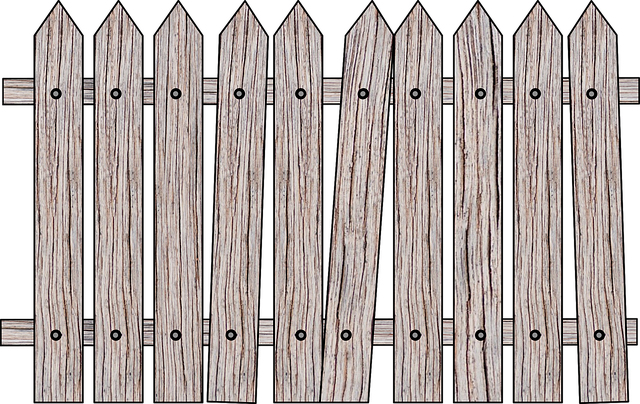In New Bedford, proper fence maintenance is essential for enhancing property values, ensuring safety, and mitigating environmental factors. This article delves into the comprehensive guide to fence repair and installation in the region. We explore common issues plaguing New Bedford residents, highlighting how local weather conditions impact fence longevity. Furthermore, it provides insights on choosing ideal materials and styles that suit individual preferences. The step-by-step installation process empowers property owners while a contrasting DIY vs professional section guides decision-making for effective repairs.
- Understanding Fence Needs: Common Issues in New Bedford
- The Role of Local Weather on Fence Maintenance
- Choosing the Right Fence: Materials and Styles
- Installation Process: Step-by-Step Guide for Property Owners
- Professional vs DIY: When to Hire Experts for Repairs
Understanding Fence Needs: Common Issues in New Bedford
In New Bedford, understanding your fence needs starts with identifying common issues prevalent in the region. One prominent challenge is weather-related damage, given the area’s exposure to harsh winters and frequent coastal storms. Strong winds, heavy snow, and ice can wreak havoc on fences, leading to loose or broken posts, warped boards, and damaged rails. Additionally, salt air from nearby seas accelerates corrosion in metal fencing, requiring regular maintenance and replacement for durability.
Another factor is the local terrain and ground conditions. New Bedford’s soil composition can vary, with some areas prone to moisture issues that may cause rot or weaken fence structures. Tree roots, too, can compromise the integrity of fences over time. Local regulations and neighborhood aesthetics also play a role; property owners may have specific requirements for fence height, materials, and design that align with community standards, impacting repair and installation choices.
The Role of Local Weather on Fence Maintenance
The local climate plays a significant role in determining how well your fence holds up over time. New Bedford, with its temperate maritime climate, experiences varying weather conditions throughout the year. The warm summers and cool, moist winters can take a toll on outdoor structures like fences. High humidity levels contribute to wood rot and mold growth, while freezing temperatures can cause metal components to expand and contract, leading to stress points and eventual damage. Regular maintenance is essential to mitigate these effects, including applying weather-resistant treatments and ensuring proper drainage around the fence to prevent water buildup.
Seasonal changes also dictate the type of fence best suited for our region. During fall and winter, strong storms can pose a particular risk, highlighting the importance of sturdy, well-installed fences that can withstand heavy winds and flying debris. In contrast, hot summers might require materials that reflect sunlight to keep the fence from overheating and warping. Understanding local weather patterns is crucial for both repairs and installations, ensuring your fence remains in top condition for years to come.
Choosing the Right Fence: Materials and Styles
When considering new Bedford fence repair or installation, selecting the right material and style is paramount to ensure both functionality and aesthetic appeal. The first step is to evaluate your needs; will the fence serve as a security measure, define property boundaries, provide privacy, or simply enhance curb appeal? Each purpose lends itself to different materials and designs. For instance, wood fences offer classic beauty but require more maintenance than vinyl or metal options, which are low-maintenance alternatives.
Styles range from traditional picket fences ideal for creating a charming, neighborhood-friendly look to robust, tall privacy fences offering maximum seclusion. Consider your property’s architecture and surrounding landscape; a fence that complements these elements will blend seamlessly into the overall design. Moreover, local building codes and homeowner associations may have guidelines regarding fence materials and heights, so it’s essential to research and comply with these regulations.
Installation Process: Step-by-Step Guide for Property Owners
When it comes to fence repair and installation, New Bedford residents can benefit from a step-by-step guide that ensures a smooth process. First, property owners should assess their needs and choose the right type of fence for their space. Wooden fences are popular for their aesthetic appeal and durability, while vinyl options offer low maintenance. Once decided, gather the necessary tools and materials. This includes posts, rails, panels, concrete, and hardware.
Next, mark the fence line accurately using string or a level. Dig holes for the posts, ensuring they’re deep enough to provide stability. Place the posts in position, check their alignment, and fill the holes with concrete. Allow it to set completely. Then, attach the rails to the posts, securing them tightly. Finally, install the fence panels, making sure they’re level and properly fastened. Regular maintenance like cleaning and painting will keep your new fence looking its best for years to come.
Professional vs DIY: When to Hire Experts for Repairs
When it comes to fence repairs and installations, deciding between professional services and DIY projects is an important choice. While some minor fixes can be tackled by homeowners, complex tasks often require the expertise of professionals. Fence repair and installation work demands specific skills and knowledge to ensure longevity and structural integrity.
Hiring experts for your New Bedford fence project has numerous advantages. Professionals bring experience, offering tailored solutions based on unique property needs. They have access to high-quality materials and tools, ensuring a durable and aesthetically pleasing finish. Additionally, professionals can provide valuable insights into local regulations and permits, saving you time and potential legal issues.
